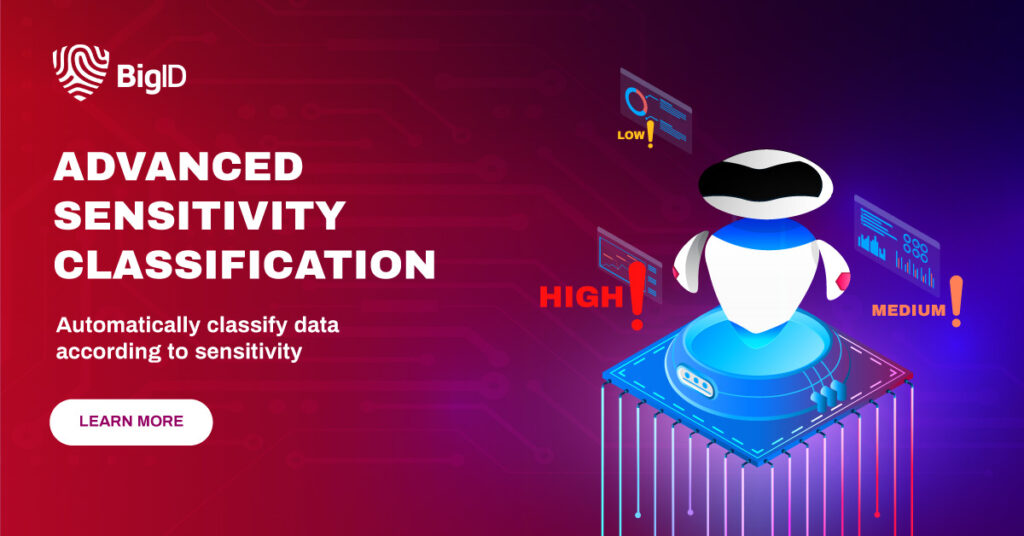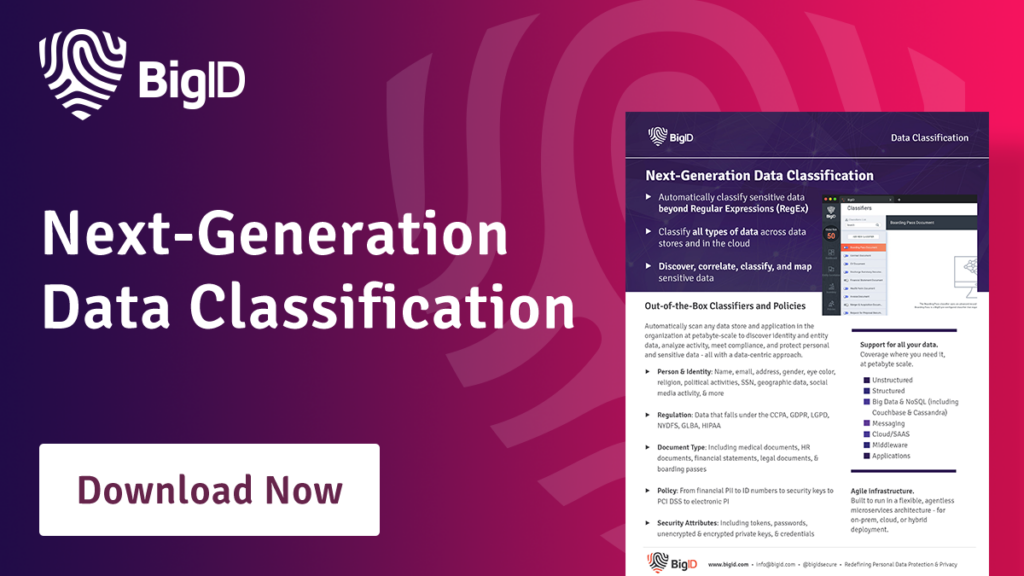Data classification is all about understanding and organizing data into defined categories and types that are relevant to a specific organization.
Classifying data by sensitivity, policy, or other attribute enables organizations to identify, organize, protect, manage, and report on data throughout its lifecycle to meet regulatory compliance and other business needs. Data classification provides a clear bridge between privacy and security initiatives. – Jennifer Glen, IDC Analyst
What is the purpose data classification?
Data classification has multiple applications — and is critical to privacy, risk mitigation, security, governance, discovery, and compliance initiatives.
With the right technology and automated classification techniques, companies can find and understand all of their data, know where it is located, identify its contents — and ultimately make better decisions around it. Those decisions may affect privacy, security, governance — or all of the above. Regardless of its application, effective data classification is a necessary starting point.
Data classification enables users — without opening or changing any file itself — to determine if the data contains sensitive, critical, personal, confidential, restricted, or otherwise regulated information. This helps organizations answer important questions like:
- where all of their data is stored
- where their most sensitive data resides
- what their data contains
- whose data it is
Why is data classification important?
Organizations can’t monitor and control data they don’t know about — or can’t find. You can’t protect your most sensitive data from theft if you don’t know where it resides. You can’t determine which types of data should remain on-prem versus which you should move to the cloud if you don’t know what the data contains. You can’t effectively respond to DSARs if you can’t determine who your data belongs to.
To optimize security and reduce costs around security efforts, effective classification can determine which data is your most valuable data so you can prioritize its protection. Meanwhile, you can allow less valuable data to live in a less monitored, more affordable environment.
What are the levels of data classification?
Data classification is typically divided into several levels, each with its own level of sensitivity. The most common classification levels are:
- Confidential: This is the highest level of sensitivity and includes information that, if disclosed, could cause harm to the organization or individual. This includes trade secrets, financial data, and sensitive personal information.
- Restricted: This level of data is sensitive and requires protection, but not to the same extent as confidential data. This may include sensitive business information, such as sales and marketing plans.
- Internal: This is data that is important to the organization but is not sensitive enough to require the same level of protection as restricted or confidential data. This may include internal reports and memos.
- Public: This is the lowest level of data classification and includes information that can be freely shared without any restrictions.

Data classification requirements
Data classification and labeling is a necessary step toward building any governance, information security, or privacy program — and it is a prerequisite for meeting regulatory compliance for GDPR, CCPA, HIPAA, PCI or just about any local, global, federal, or state compliance standard.
While some regulations require that organizations maintain certain categories for classified data (e.g., SOC2 requires a category for “confidential” data and GDPR specifies labels such as “public,” “proprietary,” “confidential,” and even “special”), not all regulations require specific categories — and this is not consistent from one to another.
Data classification best practices
Data classification is a crucial process that helps organizations protect sensitive information from unauthorized access and misuse. To ensure an effective data classification system, follow these best practices:
- Establish clear and concise policies: Organizations should create policies that outline the data classification process and the responsibilities of employees. These policies should be reviewed and updated regularly to ensure they remain relevant and effective as the organization evolves.
- Train employees: All employees should be trained on the data classification process and the importance of protecting sensitive information. This training should be ongoing, to ensure that employees are aware of the latest best practices and regulatory requirements.
- Automate classification: This can help streamline the process and reduce the risk of human error. Machine learning classification tools can help organizations accurately identify the data that is most important to them, based on various criteria such as type, policy, regulation, or industry standard.
- Monitor and review: This includes regularly assessing the data to determine its level of sensitivity and updating the controls in place to protect it. By continuously monitoring and reviewing the data classification process, organizations can stay ahead of evolving security threats and ensure their sensitive information is always protected.
Types of data classification
There are multiple ways in which organizations can classify their data, but all these ultimately fall under two main models: manual and automated classification.
Manual classification requires training data owners to classify all of a company’s data by category or label. Manual processes are not only very expensive and time-consuming, but they are impossible to scale to the exponential growth of data types, sources, and regulations.
Furthermore, like any repetitive task performed by humans, manual classification is prone to errors, leading to incomplete or incorrect classification.
Automated classification delivers effective results with less cost and less effort. Automated processes use trainable, deep-learning models that can scale and look everywhere into all of your structured and unstructured data, at rest and in motion. This allows you to apply data classification rules consistently and dynamically as the data moves across its lifecycle.
GDPR impacts on data classification
Data classification is a vital component of data management that enables organizations to achieve compliance with regulations such as the General Data Protection Regulation (GDPR). The GDPR is a regulation instituted by the European Union that strives to safeguard the privacy and personal data of EU citizens. Organizations that handle personal data of EU citizens must comply with the GDPR regulations or face substantial fines and penalties. By utilizing data classification, organizations can categorize data based on its type, sensitivity, and importance.
This allows organizations to understand the level of protection required for each type of data and ensures it is stored, processed, and transmitted securely. In doing so, organizations can better manage their data, improve data security, and meet the requirements of the GDPR, thus protecting the privacy of personal data.
Data classification examples
BigID approaches data classification differently. It embraces a discovery in-depth approach that goes deep and wide: finding data wherever it is and layering in context and correlation for classification.
BigID’s classification approach extends and enhances traditional classification methods while also expanding coverage over multiple types of sensitive information — from personally identifiable information to profile information to broader sensitive information.
For example, a particular large retailer uses BigID to classify and identify where sensitive and critical data resides in their organization — and how to protect it.
The company has been using BigID for a global initiative to discover and classify sensitive, critical, and personal data across all of their 1,200+ data sources — and for more than 73,000 employees. With a unified inventory of their data, the customer has started broader governance initiatives.
Enhance Data Classification Capabilities with BigID
Data classification creates a huge chunk of the bedrock of any data privacy, security, and governance initiative — and so it must be a high priority for organizations that want to protect their sensitive data and maintain regulatory compliance.
To properly manage and secure valuable data, firms need to know their data, understand their data, and be able to easily answer: what it is, where it is, and who it belongs to.
BigID provides a powerful, intuitive platform and highly effective, easy-to-use data classification that leverages machine learning. Organizations can quickly and automatically identify sensitive and critical data across hundreds of data sources and build tailored data governance strategies to manage, monitor, and protect all their data.
Data Classification with BigID looks like:
Regular expression and pattern matching
The traditional, pattern-based classification relies on regular expressions and patterns to find exact matches in strings of data. BigID has modernized this approach and added security identifiers. For instance, organizations can identify security-focused data points like API keys, credentials, tokens, and even common passwords.
Contextual classification
BigID leverages Machine Learning (ML) and Named Entity Recognition (NER) to automatically identify sensitive information and link that specific instance of sensitive information into an individual identity or profile.
File classifier by type
Machine-learning models automatically classify documents based on the content and structure of a file — without being limited to any specific data classifier. These models can recognize sensitive file types like financial statements or boarding passes.
Policy-based classification
BigID has built-in policy libraries to help classify, manage, and protect specific types of data by policy. This enables organizations to build workflows across specific types of data, manage access, monitor use, and protect sensitive data that may be under attack.
Schedule a demo to learn more about how BigID can help you to know your data with ML-based classification.

